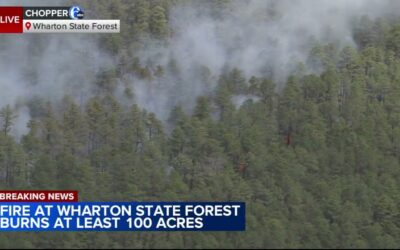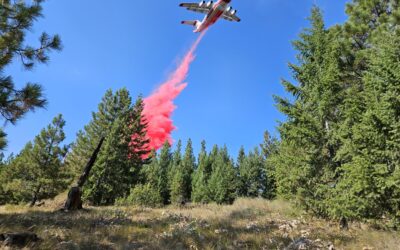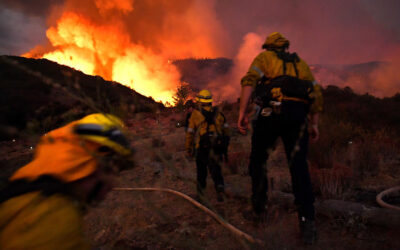ALBUQUERQUE, N.M. (AP) — The U.S. government is entering a new era of collaboration with Native American and Alaska Native leaders in managing public lands and other resources, with top federal officials saying that incorporating more Indigenous knowledge into decision-making can help spur conservation and combat climate change.
Federal emergency managers on Thursday also announced updates to recovery policies to aid tribal communities in the repair or rebuilding of traditional homes or ceremonial buildings after a series of wildfires, floods and other disasters around the country.
Wth hundreds of tribal leaders gathering in Washington this week for an annual summit, the Biden administration is celebrating nearly 200 new agreements that are designed to boost federal cooperation with tribes nationwide.
The agreements cover everything from fishery restoration projects in Alaska and the Pacific Northwest to management of new national monuments in the Southwestern U.S., seed collection work in Montana and plant restoration in the Great Smoky Mountains.
“The United States manages hundreds of millions of acres of what we call federal public lands. Why wouldn’t we want added capacity, added expertise, millennia of knowledge and understanding of how to manage those lands?” U.S. Interior Assistant Secretary Bryan Newland said during a panel discussion.
The new co-management and co-stewardship agreements announced this week mark a tenfold increase over what had been inked just a year earlier, and officials said more are in the pipeline.
Newland, a citizen of the Bay Mills Indian Community in northern Michigan, said each agreement is unique. He said each arrangement is tailored to a tribe’s needs and capacity for helping to manage public lands — and at the very least assures their presence at the table when decisions are made.
The federal government is not looking to dictate to tribal leaders what a partnership should look like, he said.
The U.S. government controls more than a quarter of the land in the United States, with much of that encompassing the ancestral homelands of federally recognized tribes. While the idea of co-stewardship dates back decades and has spanned multiple presidential administrations, many tribes have advocated in recent years for a more formal role in managing federal lands to which they have a connection.
Tribes and advocacy groups have been pushing for arrangements that go beyond the consultation requirements mandated by federal law.
Researchers at the University of Washington and legal experts with the Native American Rights Fund have put together a new clearinghouse on the topic. They point out that public lands now central to the country’s national heritage originated from the dispossession and displacement of Indigenous people and that co-management could present on opportunity for the U.S. to reckon with that complicated legacy.
Ada Montague Stepleton, a staff attorney with the Native American Rights Fund, said the significant uptick in the number of agreements signed just in the past year show there’s a willingness in Indian Country to find a path forward that is mutually beneficial to tribes and the federal government — and ultimately taxpayers.
“We’ve been compiling information to try to understand these agreements better,” she said. “There is a sort of a double-edged sword. We want to make sure that sovereignty isn’t eroded while at the same time creating places where co-management can, in fact, occur.”
Montague Stepleton said one of the challenges is that tribes often have few resources, with much of their attention going toward maintaining their cultures and ensuring their communities have access to food, water and health care.
In an attempt to address complaints about chronic underfunding across Indian Country, President Joe Biden on Wednesday signed an executive order on the first day of the summit that will make it easier for tribes to find and access grants.
Deanne Criswell, administrator of the Federal Emergency Management Agency, told tribal leaders Thursday that her agency began work this year to upgrade its disaster guidance particularly in response to tribal needs.
The Indigenous people of Hawaii have increasingly been under siege from disasters, most recently a devastating fire that killed dozens of people and leveled an entire town. Just last month, another blaze scorched a stretch of irreplaceable rainforest on Oahu.
Tribes in California and Oregon also were forced to seek disaster declarations earlier this year after severe storms resulted in flooding and mudslides.
Nancy James, first chief of the Gwichyaa Zhee Gwich’in Tribal Council in Alaska, said the effects of climate change on tribal communities can’t be ignored.
“Reality check,” she said, after ticking off details about warmer temperatures, bears not hibernating as they should and the inability of her people to fish due to changing water conditions. “Global warming has affected every one of us.”
Criswell said the new guidance includes a pathway for Native American, Alaska Native and Hawaiian communities to request presidential disaster declarations, providing them with access to emergency federal relief funding.
The agency also is now accepting tribal self-certified damage assessments and cost estimates for restoring ceremonial buildings or traditional homes, while not requiring site inspections, maps or other details that might compromise culturally sensitive data.




